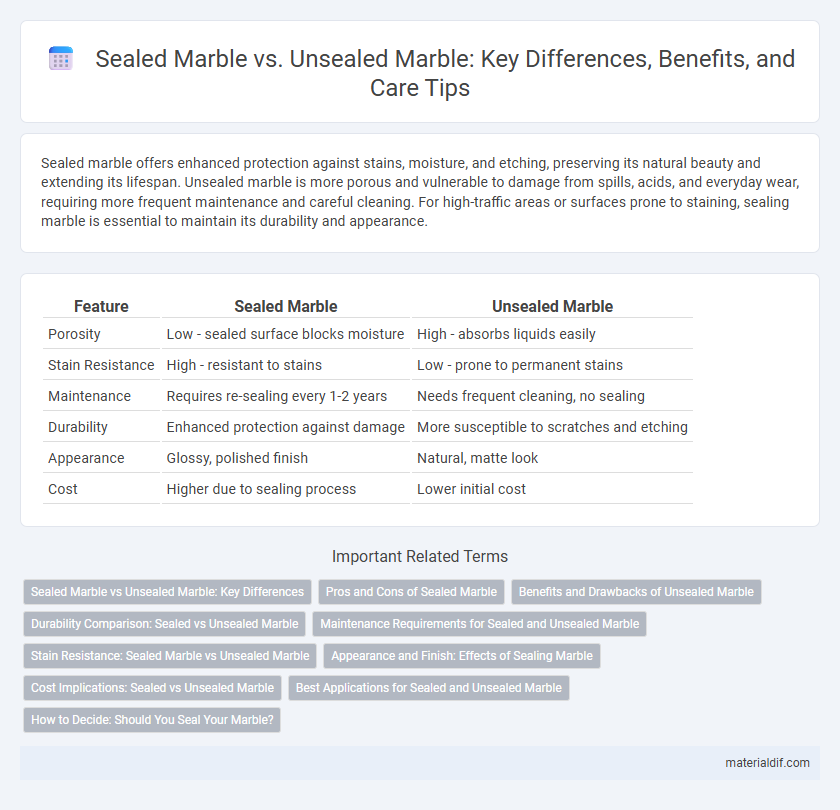Sealed marble offers enhanced protection against stains, moisture, and etching, preserving its natural beauty and extending its lifespan. Unsealed marble is more porous and vulnerable to damage from spills, acids, and everyday wear, requiring more frequent maintenance and careful cleaning. For high-traffic areas or surfaces prone to staining, sealing marble is essential to maintain its durability and appearance.
Table of Comparison
| Feature | Sealed Marble | Unsealed Marble |
|---|---|---|
| Porosity | Low - sealed surface blocks moisture | High - absorbs liquids easily |
| Stain Resistance | High - resistant to stains | Low - prone to permanent stains |
| Maintenance | Requires re-sealing every 1-2 years | Needs frequent cleaning, no sealing |
| Durability | Enhanced protection against damage | More susceptible to scratches and etching |
| Appearance | Glossy, polished finish | Natural, matte look |
| Cost | Higher due to sealing process | Lower initial cost |
Sealed Marble vs Unsealed Marble: Key Differences
Sealed marble offers enhanced protection against stains, moisture, and etching, preserving its polished appearance for a longer time, while unsealed marble is more porous and susceptible to damage from spills and environmental factors. The sealing process fills the stone's microscopic pores, reducing absorbency and making maintenance easier compared to unsealed marble, which requires frequent cleaning and careful handling. Cost-wise, sealed marble involves additional upfront investment for sealing products and labor but can save on long-term restoration expenses caused by unsealed marble's vulnerability.
Pros and Cons of Sealed Marble
Sealed marble offers enhanced protection against stains, moisture, and etching by creating a barrier that reduces absorption, making it ideal for kitchen countertops and high-traffic areas. The sealant preserves the stone's natural luster and extends its durability while requiring periodic resealing to maintain effectiveness. However, sealed marble can sometimes alter the stone's appearance slightly and needs consistent upkeep to prevent seal failure and potential damage.
Benefits and Drawbacks of Unsealed Marble
Unsealed marble offers a natural, authentic appearance that many homeowners and designers prefer for its raw beauty and unique veining patterns. However, it is highly porous and prone to staining, etching, and damage from acidic substances, requiring frequent cleaning and maintenance. Without a sealant, unsealed marble is more susceptible to moisture absorption, which can lead to discoloration and reduced durability over time.
Durability Comparison: Sealed vs Unsealed Marble
Sealed marble exhibits significantly higher durability by resisting stains, moisture, and etching, extending the lifespan of the surface in high-traffic or wet areas. Unsealed marble remains porous, making it vulnerable to absorption, discoloration, and damage from acidic substances, which accelerates wear and surface degradation. Maintaining sealed marble with periodic resealing enhances longevity, while unsealed marble requires more frequent repair and replacement due to its susceptibility to damage.
Maintenance Requirements for Sealed and Unsealed Marble
Sealed marble requires regular resealing every 6 to 12 months to maintain its protective barrier against stains and moisture, significantly reducing the need for intensive cleaning. Unsealed marble, lacking this protective layer, demands more frequent cleaning and immediate stain removal to prevent etching and discoloration. Proper maintenance of sealed marble extends its lifespan and preserves its polished appearance, while unsealed marble is more prone to damage and requires careful upkeep to avoid irreversible surface wear.
Stain Resistance: Sealed Marble vs Unsealed Marble
Sealed marble offers superior stain resistance compared to unsealed marble by creating a protective barrier that prevents liquids from penetrating the porous surface, reducing the risk of discoloration and damage. Unsealed marble absorbs spills quickly, making it highly susceptible to stains from substances like wine, oil, and acidic foods. Regular sealing enhances marble's durability and maintains its aesthetic appeal by minimizing staining and easing maintenance efforts.
Appearance and Finish: Effects of Sealing Marble
Sealed marble exhibits a glossy, polished surface that enhances color depth and provides a uniform appearance, preventing stains and discoloration. Unsealed marble tends to have a matte, porous finish that absorbs liquids and dirt, leading to dull spots and uneven coloration over time. Sealing marble preserves its aesthetic appeal, maintaining brightness and smoothness while protecting against etching and surface damage.
Cost Implications: Sealed vs Unsealed Marble
Sealed marble typically requires a higher upfront cost due to the price of sealants and professional application, but it offers long-term savings by preventing stains and reducing maintenance expenses. Unsealed marble has a lower initial cost but can lead to increased cleaning, repair, and replacement costs over time because it is more vulnerable to damage from spills and wear. Evaluating the total cost of ownership, sealed marble often proves more cost-effective despite the initial investment.
Best Applications for Sealed and Unsealed Marble
Sealed marble is ideal for high-traffic areas such as kitchens and bathrooms due to its enhanced resistance to stains, moisture, and etching, making it suitable for countertops and flooring. Unsealed marble is best applied in low-traffic, decorative spaces like fireplace surrounds or accent walls where natural aging and patina add aesthetic value without requiring frequent maintenance. Choosing between sealed and unsealed marble depends on the balance between durability needs and desired natural texture for interior or architectural applications.
How to Decide: Should You Seal Your Marble?
Sealing marble enhances its resistance to stains, moisture, and etching, making it ideal for high-traffic or spill-prone areas such as kitchens and bathrooms. Unsealed marble maintains natural breathability and appearance but requires more frequent maintenance and is vulnerable to damage from acids and liquids. To decide whether to seal your marble, consider the location, usage patterns, and desired level of protection against wear and environmental exposure.
Sealed Marble vs Unsealed Marble Infographic

 materialdif.com
materialdif.com